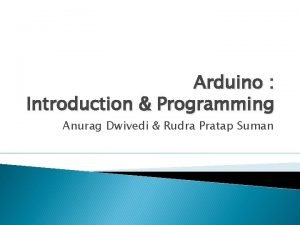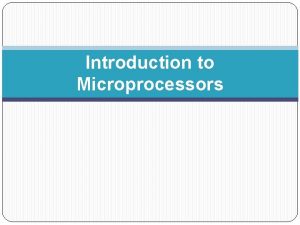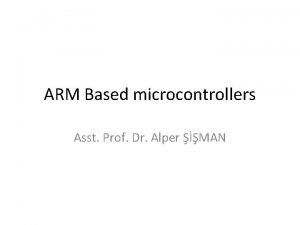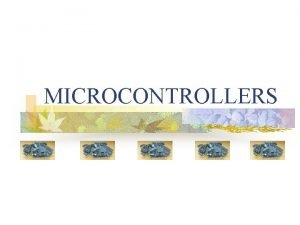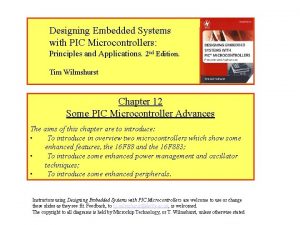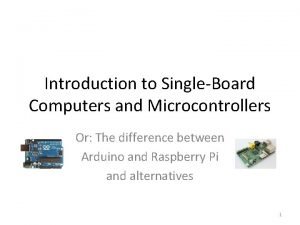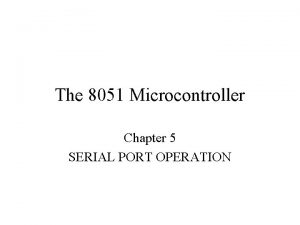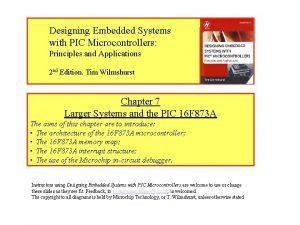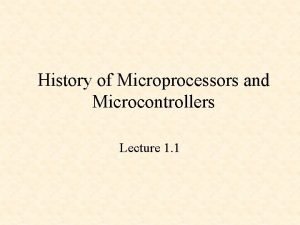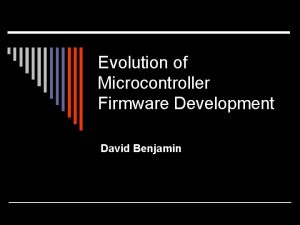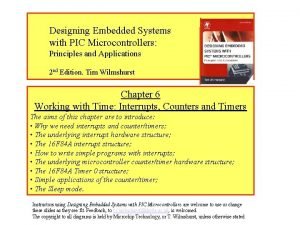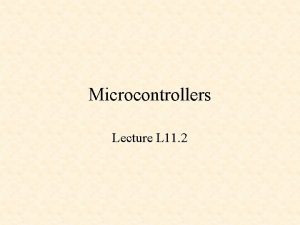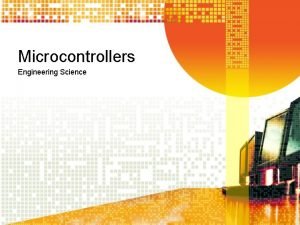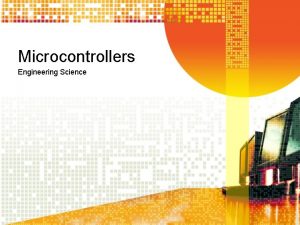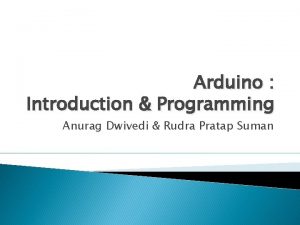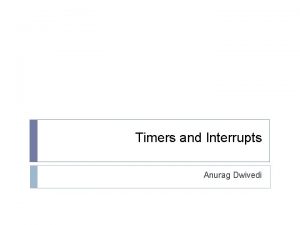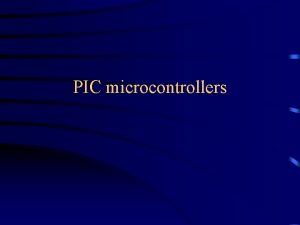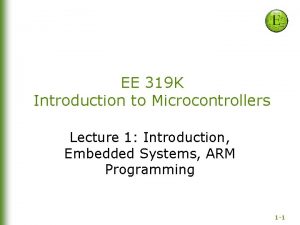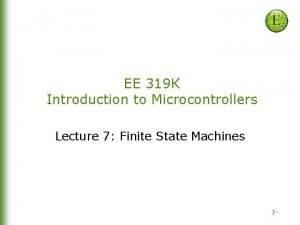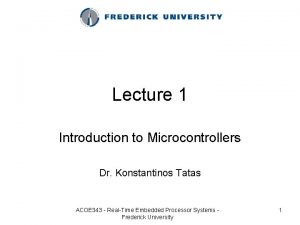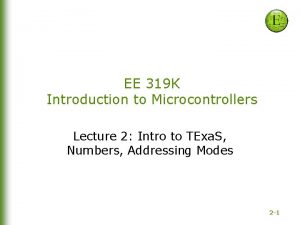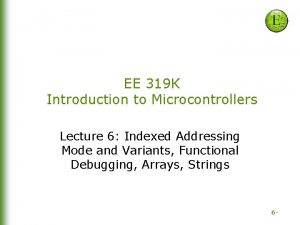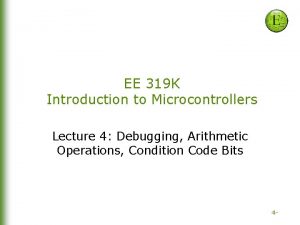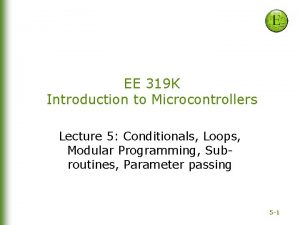Introduction to Microcontrollers Anurag Dwivedi Lecture Structure Things






















- Slides: 22

Introduction to Micro-controllers Anurag Dwivedi

Lecture Structure � Things � What to be covered today. . is a micro-controller? � What are the basic features of a micro-controller? � How to input and output from a micro-controller? � How to program a micro-controller? � Demonstration : Led Blinking. � Interfacing Character LCD with Micro-controller. � Demonstration : CLCD Interfacing.

Embedded Systems � Layman definition: Gadgets and devices � Technical definition: Self-controlled devices � Usually, such systems consist of I/O (input/output) devices such as LCDs, keypads, etc. and other devices like EEPROM (for storing data) connected to a central controlling device.

Example : MP 3 Player

The Micro-controller � Why “micro”? � Larger controllers are available too: processors that run computers are an example. � A microcontroller is essentially a mini-computer inside a single IC.

Micro-controllers � Multiple microcontrollers available in the market. � Vendors include Atmel, Intel, ARM, Cypress, etc. � We will use Atmel ATmega microcontrollers because they are cheap, easy to use and powerful.

Atmega 16 � 40 pin IC. � 32 pins for I/O. � 8 pins reserved. � I/O pins divided into 4 groups of 8 pins, called ports. � Ports labeled as A, B, C and D.

How does a micro-controller work � Just like a computer, a microcontroller executes a program. � The task to be performed is written in a while loop, and the micro-controller performs is endlessly. � The program for a microcontroller is written in C language (although other languages are possible).

Input/Output (I/0) � Input / Output is via special variables called “registers”. � Registers are actual hardware memory locations inside the μC. Their names and sizes are predefined. � When we assign a value to these registers in the program, the actual value in the hardware changes. � These values can be changed multiple times at any point in the program.

I/O Registers � There are 3 registers that control the I/O pins: DDR, PORT and PIN. � Each port has it’s own registers. Hence, port A has registers DDRA, PORTA, PINA; port B has registers DDRB, PORTB, PINB; and so on. � DDR, PORT and PIN serve different functions.

DDR ( Data Direction Register ) � DDR decides whether the pins of a port are input pins or output pins. � If the pin is input, then the voltage at that pin is undecided until an external voltage is applied. � If the pin is output, then the voltage at that pin is fixed to a particular value (5 V or 0).

Setting Register Values � DDR is an 8 bit register. Each bit corresponds to a particular pin on the associated port. � For example, the MSB on DDRA corresponds to the pin A 7.

Interpretation of DDR Values � If a bit on the DDR register is 0, then the corresponding pin on the associated port is set as input. � Similarly, if the bit is 1, then the pin is set as output. � Example: if DDRA = 0 b 10010110, then:

PORT Register � PORT is also an 8 bit register. The bits on the PORT register correspond to the pins of the associated port in the same manner as in the case of the DDR register. � PORT is used to set the output value. � If the pin is set as output, then a PORT value of 1 will set voltage at that pin to 5 V. If PORT value is 0, then voltage is set to 0 V.

Pull Up / Pull Down � What if we try to set the PORT value of a pin that is configured as input? � A separate purpose is served: that of pull up or pull down. � When an input pin is connected by a wire to some specific voltage, it’s voltage also becomes that same value.

Pull Up/ Pull Down � But, when the input pin is left free, it’s voltage value is undecided. This is bad. � To prevent this, a “default” value is assigned. This value can be either 5 V or 0, and is of consequence only when the pin is unconnected. � The PORT value becomes this “default” value. � If “default” value is 0, then pin is pulled down. If it is 5 V, then it is pulled up.

Pin Register � PIN is a register whose value can be read, but cannot be changed inside the program. � It gives the value of the actual voltage at a particular pin. 5 V corresponds to 1, and 0 corresponds to 0.

Summary

Some C concepts �| is bitwise OR. Eg. 10100111 | 11000101 = 11100111 � & is bitwise AND. Eg. 10100111 & 11000101 = 10000101 � ~ is bitwise NOT. Eg. ~10100110 = 01011001 � << is shift left. >> is shift right.

Simplest C program for a micro-controller int main(){ return 0; }

Example Program 1 #include <avr/io. h> int main(){ DDRA = 0 b 1111; // or 255 or 0 x. FF while(1){ PORTA = PINC; } return 0; }

Example Program 2 #include <avr/io. h> #include <util/delay. h> int main(){ DDRA = 0 x. FF; while(1){ PORTA = 0 x. AA; _delay_ms(1000); PORTA = 0 x 55; _delay_ms(1000); } return 0; }
 Quantanization
Quantanization Dr amit dwivedi louisville ky
Dr amit dwivedi louisville ky Satyajit dwivedi
Satyajit dwivedi Introduction to microprocessors and microcontrollers
Introduction to microprocessors and microcontrollers Introduction to microcontrollers
Introduction to microcontrollers Dr anurag mehta
Dr anurag mehta Diary entry on my debut in a cricket match
Diary entry on my debut in a cricket match Anurag acharya google
Anurag acharya google Refeeding syndrome electrolytes
Refeeding syndrome electrolytes Anurag lehtonen
Anurag lehtonen 01:640:244 lecture notes - lecture 15: plat, idah, farad
01:640:244 lecture notes - lecture 15: plat, idah, farad Hello edge: keyword spotting on microcontrollers
Hello edge: keyword spotting on microcontrollers Arm based microcontrollers
Arm based microcontrollers Embeded microcontroller
Embeded microcontroller Embedded innovator winter 2010
Embedded innovator winter 2010 Designing embedded systems with pic microcontrollers
Designing embedded systems with pic microcontrollers Microcontroller vs single board computer
Microcontroller vs single board computer Number of modes of operation of serial port are
Number of modes of operation of serial port are Designing embedded systems with pic microcontrollers
Designing embedded systems with pic microcontrollers History of microcontrollers
History of microcontrollers Evolution of microcontroller
Evolution of microcontroller Designing embedded systems with pic microcontrollers
Designing embedded systems with pic microcontrollers Conclusion paragraph format
Conclusion paragraph format
